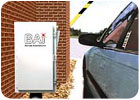ID SYSTEMS: Over the River, By Barcode

Besides the interface factor, barcode identification at designated eastbound-gated lanes of the Thomas J. Hatem Memorial Bridge is viewed by drivers as the best secured bargain in town.
Barcode readers operating at the Thomas J. Hatem Memorial Bridge offer commuters a bargain crossing near Chesapeake Bay. Located at the point where the Susquehanna River meets the town of Perryville in northeast Maryland, the steel structure quickly links local commuters to job centers.
The Memorial Bridge is the oldest of the seven bridges operated by the Maryland Transportation Authority (MdTA). For 200 year, ferries freighted goods across the river until 1910, when a group of private citizens organized to convert a railway bridge over the river into a toll bridge.
Documents show that because the railway structure was very narrow, cars barely fit; as a consequence, frequent sideswipe accidents were reported. In the 1920s, the state roads commission, later known as MdTA, took over the bridge and added a second deck to accommodate two-way travel. But the two levels proved just as troublesome because commercial trucks carrying high loads got stuck in the lower deck. Sometime later, the dilemma was resolved when the state authority decided to raze the old bridge and build a new steel bridge further upstream from the old double-decker. The modernized $5 million, 1.5-mile superstructure was completed in 1940 with four lanes and a string of 52 piers sunk 117 feet below the surface.
Barcode option
MdTA reports toll collection at the bridge began with manual collection at the gate and then they introduced exact-change machines. Subsequently in 1976, a dramatic shift occurred when they introduced the first generation of electronic barcode readers with automatic vehicle identification (AVI) decals. By 2003, the state-issued E-ZPass was developing into seamless electronic-toll collection throughout the northeastern United States. At the Memorial Bridge, planners designated E-ZPass lanes and also approved purchase of six BA-200 units manufactured by Barcode Automation Inc. of Winter Springs, Fla.
The basic system consists of the barcode reader, which is mounted near the gate, and the barcode decals, which are applied to vehicles or ID cards. The barcode readers use laser diode technology to decode encrypted information contained on the unique and inexpensive decals. User friendly, the system interfaces easily with existing applications via RS232 serial port and Wiegand 26-bit output. Altogether, MdTA offers daily commuters the option of E-ZPass along with the choice of the latest in barcode decoding technology.
Robert Polm of the MdTA electronic toll-collection unit at Hatem plaza said that besides the interface factor, the decision to retain the barcode system at designated eastbound-gated lanes was due to its popularity as the best bargain in town. While the state E-ZPass collects $5 to cross the bridge, commuters can opt to purchase an annual $5 bar-coded decal, which offers unlimited trips for one year through the gated lanes. The annual pass pays for itself, even if motorists drive through the bridge once. In fact, out-of-state commuters who frequent the area have purchased the decals simply to avoid the higher E-ZPass toll fee.
One major advantage of the barcode system seen at the plaza was increased traffic flow; since vehicles are read automatically, they can move through the designated gate as quickly as it can open. In other words, the validation process takes a fraction of a second after the decal is detected. If the ID is valid, access is allowed; so, for all practical purposes, vehicles can pass through without stopping. Depending on the manufacturer, the maximum speed that a vehicle can pass by the reader varies up to 25 mph. This relatively low vehicle speed is not a problem for most gated plazas.
Also, barcode readers today will read a standard-size AVI decal at a 6-foot distance in direct sunlight. The decals are printed on retro-reflective material, which has a five-year life expectancy when used outdoors. This is the same material used to make letters and graphics for street signs and is intended to be used outdoors. The BAI barcode readers are designed to read the specific material that AVI barcodes are made from.
The barcode reader will not recognize a paper photocopy of the genuine label.
With 9.3-million vehicles crossing the bridge over the past fiscal year, Polm says the system keeps daily commuters moving quickly over the bridge in a cost-effective manner.
Looking for a reprint of this article?
From high-res PDFs to custom plaques, order your copy today!





